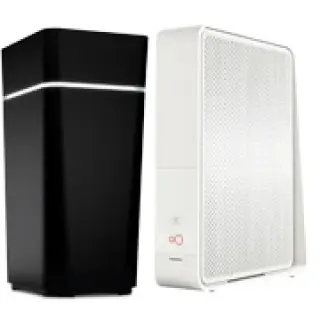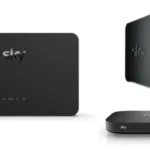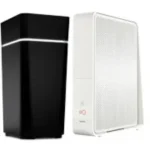Virgin Media offers two current-generation routers in 2025: the Hub 5 and the Hub 5x. Which one you receive depends on the type of broadband connection available at your address. Homes on the older cable network (DOCSIS 3.1) will get the Hub 5. Those in full fibre areas (XGS-PON) will get the Hub 5x.
While both hubs support fast Wi-Fi, app-based controls and Virgin’s mesh system (WiFi Max), there are a few technical differences—especially in how they connect and the ports they provide.
Quick Specs at a Glance
Hub 5 (Cable – DOCSIS 3.1):
- Wi-Fi 6, dual-band (2.4GHz 3×3, 5GHz 4×4)
- 1x 2.5Gbps Ethernet port
- 3x 1Gbps Ethernet ports
- Compatible with WiFi Max mesh pods
- Coaxial cable input
Hub 5x (Full Fibre – XGS-PON):
- Wi-Fi 6, dual-band (2.4GHz 3×3, 5GHz 4×4)
- 1x 10Gbps Ethernet port
- 3x 1Gbps Ethernet ports
- Optical WAN port (no coax)
- Compatible with WiFi Max mesh pods
Both support guest networks, WPS pairing, and Virgin’s Intelligent WiFi features.
Setup Process – Cable vs Full Fibre
Setting up your hub depends on the type of broadband line coming into your home.
For Hub 5 (Cable):
You’ll unplug the coax cable from your old router and connect it to the Hub 5. Once powered on, the hub takes a few minutes to authenticate with Virgin’s network. The Wi-Fi name and password are printed on the back of the unit, or you can use the Virgin Media Connect app to finish setup.
For Hub 5x (Full Fibre):
This version connects using an optical fibre port. There’s no coax involved. The fibre line plugs into the back of the hub, and the router activates automatically if the signal levels are good. Wi-Fi setup is the same as the Hub 5—use the printed credentials or the app.
If you’ve signed up for WiFi Max, you can pair the mesh pods through the app. They extend your main Wi-Fi network and help eliminate dead zones in larger homes. Virgin’s WiFi Max also comes with a guarantee: if you can’t get 30Mbps in every room, you’ll receive up to three pods. If that still doesn’t fix the issue, Virgin promises £100 credit.
Day-to-Day Wi-Fi Performance
Both hubs use Wi-Fi 6, which gives much better speeds and handling of multiple devices compared to older Wi-Fi 5 routers. You’ll notice quicker page loads and more consistent video streaming on phones, laptops, and tablets that support Wi-Fi 6.
For wired connections, the Hub 5 has a 2.5Gbps Ethernet port, while the Hub 5x has a 10Gbps port. These ports give enough headroom for ultra-fast plans like Gig1 or Gig2, especially if you’re using network storage or connecting to high-speed desktops or consoles.
If you’re using the Hub 5 in modem mode:
Many users report smooth performance when connecting it to their own routers or mesh systems. Just make sure to use the correct port (usually the first LAN port), and follow the correct reboot steps so that your own router gets assigned an IP address.
For Hub 5x:
As of 2025, modem mode is not available in most areas. Some community members have reported test versions or temporary solutions, but in general, you’ll need to use the 5x in router mode unless Virgin enables modem mode in the future.
Troubleshooting tip:
If you’re getting a 1Gbps cap on speed tests, even though you’re using the faster ports, check every link in your setup. This includes switches, Ethernet cables, and the WAN port on your own router. Older Cat5 cables or 1Gbps switches could be the bottleneck.
Which Hub Do You Get With Which Plan?
- M125, M250, M350, M500, and Gig1: These cable broadband packages generally include the Hub 5. Some older customers on entry-level plans may still receive the Hub 3, but this is becoming less common.
- Gig2 (Full Fibre): This plan uses the Hub 5x with the 10Gbps port.
Your router will match the type of network you’re on. If you’re on coaxial cable, you’ll get the Hub 5. If you’re on Virgin’s newer fibre-only lines, you’ll get the Hub 5x.
As with most broadband setups, your actual Wi-Fi speed won’t always hit the headline package number. Devices closer to the router will perform better. For the most reliable results on Gig1 or Gig2, use a wired connection.
Virgin Media WiFi Max Guarantee
WiFi Max is Virgin’s premium mesh service that uses plug-in pods to extend coverage. The setup is done through the Virgin Media Connect app and the entire network runs on one SSID, so you don’t need to manually switch between signals.
Virgin guarantees 30Mbps in every room. If you don’t get that, they’ll send up to three pods to improve coverage. If that still doesn’t fix it, you’ll receive £100 credit. That’s a clear commitment, which most broadband providers don’t offer.
Pod placement matters. Keep them in open areas and avoid stacking them too close to the hub or to each other. Each pod should have a good line of sight to the next point in your home.
Pros, Cons, and What’s Missing
Pros:
- Wi-Fi 6 support gives fast and consistent wireless speeds on modern devices.
- Multi-gig Ethernet ports on both models are ideal for gamers and high-speed streaming.
- WiFi Max pods with a performance guarantee take care of home coverage issues.
- Virgin’s app-based setup and control is user-friendly and well integrated.
Cons:
- Hub 5x lacks modem mode at the time of writing. This limits advanced setups with third-party routers.
- Some customers hit speed caps because of their own networking gear. You’ll need Cat6 or better cables and multi-gig compatible switches to get full speeds.
What’s not included:
- There’s no Wi-Fi 6E or Wi-Fi 7. If you need access to the 6GHz band or future-proof latency features, you’ll need to buy a third-party mesh system.
- DECT support for landlines, like on BT’s Smart Hub 2, is not present here.
How It Stacks Up Against Other ISP Routers
BT Smart Hub 2
Wi-Fi 5, four Gigabit Ethernet ports, and built-in DECT for BT Digital Voice. It’s reliable for most users but lacks the faster Wi-Fi 6 performance. Doesn’t come with multi-gig ports.
Sky WiFi Max Hub
Wi-Fi 6 and supports a full mesh setup with booster pods and a room-by-room speed guarantee. Also offers app-based controls, like Virgin.
Vodafone Ultra Hub 7 (Pro 3)
Supports Wi-Fi 7 with 6GHz, dual 2.5GbE ports, and optional 4G backup. It’s a future-facing router designed for dense households and fast wireless connections.
Virgin’s advantage lies in offering multi-gig ports today, even though its Wi-Fi spec is slightly behind Vodafone’s. Combined with the WiFi Max guarantee, it’s a reliable setup for most UK homes.
Verdict
If you’re a Virgin Media broadband customer in 2025, the Hub 5 and Hub 5x are both good routers for their respective networks. Wi-Fi 6 gives strong wireless performance, and the faster Ethernet ports provide the speeds needed for streaming, gaming, and heavy downloads.
For most households, the default setup plus WiFi Max pods gives more than enough coverage and consistency. If you’re on Gig1 or Gig2, plugging in your main devices via Ethernet makes a noticeable difference.
However, if you’re planning to build a high-end custom network or already use your own router, only the Hub 5 currently supports modem mode. The 5x may feel more limited until that changes.
There’s no Wi-Fi 6E or Wi-Fi 7 onboard yet, but unless you have a lot of next-gen devices, you probably won’t miss them. If you want the absolute cutting edge, a third-party mesh kit is the next step.
FAQs
Which router will I receive from Virgin Media?
You’ll get the Hub 5 if your area uses coaxial cable (DOCSIS). If you’re in a full-fibre area, you’ll get the Hub 5x.
Can I use modem mode with the Hub 5?
Yes. Modem mode is available and lets you use your own router. You’ll need to use the first LAN port and follow Virgin’s reboot instructions to ensure the connection works properly.
Does the Hub 5x support modem mode?
Currently, no. Virgin doesn’t offer modem mode on the Hub 5x in most areas. This may change later, but for now, you’ll need to use it in router mode.
What is WiFi Max and how does it work?
WiFi Max is Virgin’s mesh Wi-Fi system. It guarantees at least 30Mbps in every room. If your speeds are lower, Virgin will send up to three pods. If coverage is still poor, they’ll credit your account with £100.
How fast is Wi-Fi on the Hub 5 and 5x?
Wi-Fi speed varies by device, distance, and layout. On newer phones and laptops that support Wi-Fi 6, you’ll see fast and consistent speeds, especially on the 5GHz band. For best results on Gigabit packages, use Ethernet where possible.
Where should I place the router and mesh pods?
Keep the main hub in an open area and don’t hide it in a cabinet. Place pods midway between the hub and the areas you want to cover, with a clear path through doorways or halls. Use the Virgin Media Connect app to test speeds in each room.





